Five Tips for Easier Rearranging of iOS Apps
Don’t miss our followup article, “Manage iPhone Home Screen Apps in Bulk with iOS 14’s App Library” (19 April 2021), which extends some of these techniques to show you how you can add and remove multiple apps from iOS 14 Home screens using the App Library.
After Josh Centers wrote “iOS 14’s App Library: The FAQ” (9 September 2020), we got a great response in the comments. Several people noted that they have long relied on a technique not dissimilar to the App Library, in that they devote one or more Home screens to a carefully organized set of folders that contain all their less-used apps. I admire such attention to detail, and in an ideal world, I’d use a similar approach.
However, I have 352 apps installed (check your number in Settings > General > About). Since the loss of the organizational tools in iTunes, the immense effort in dragging hundreds of icons around has dissuaded me from cleaning things up. Adding Home screen widgets in iOS 14 can also mess up app organization—something I did while playing with widgets deleted about half of my folders on one Home screen. So I was stoked to read John Clark’s post explaining how to move multiple apps at once. Even better, as soon as I started using multiple fingers, I discovered yet another app rearrangement tip that makes life much easier.
So, as welcome as iOS 14’s App Library may be for many of us, particularly alongside being able to hide Home screens, here is a collection of tips that will help anyone rearrange their app icons more easily, regardless of iOS version or device.
The Basics
First, let’s make sure we’re all on the same page.
- To move an app, start by touching and holding it. In recent versions of iOS, you can start dragging the app as soon as you feel a click, or you can pause until you see a popover, in which you can tap Edit Home Screen. In earlier versions of iOS, you’d touch and hold until you entered jiggle mode. (Interestingly, the Apple Style Guide is clear that it’s not “wiggle mode.”) Drag the app to the desired location.
- To put the app on a different Home screen, drag to the left or right edge of the screen and pause briefly to switch screens.
- To create a new folder, drag one app on top of another and pause briefly. Rename the folder as desired.
- To put an app in a folder, drag it into the folder. If you pause over the folder, it opens, and you can drag the app into place within the folder or even to other pages within the folder.
- To delete a folder, drag all the apps in it to another folder or Home screen.
- When you’re done, press the Home button or swipe up from the bottom of the screen to leave jiggle mode.
Want to see a demo of this? Josh Centers whipped up this quick video.
Clear Space on the Dock and Use It as a Temporary Holding Zone
This tip isn’t new, but it’s worth repeating. If you’re doing a lot of app cleanup across multiple Home screens, dragging the app a long distance can be tiring and frustrating, particularly if you end up hovering over another app just slightly too long and invoking the folder creation process.
But if you think about it, you can save yourself a lot of the stress of moving apps by moving one or more of your Dock apps to a temporary spot and then using the Dock as a holding zone. You can then put some number of apps on the Dock, navigate to the desired Home screen, and drag them out in multiple small steps, without having to keep your finger down the entire time.
It’s much faster than moving each app, one a time, especially if you have a lot of Home screens.
Josh made another short video to show how this works.
Move a Stack of Apps All at Once
John Clark’s tip takes the idea of working with multiple apps to a higher level, letting you assemble a stack of apps and put them in a new location with a single drop. Here’s how.
Start by moving one app. Once you’ve picked it up, I recommend dragging it to the lower-right corner of its Home screen. That’s not necessary, but it makes seeing what you’re doing easier. Without letting go of the app you’ve picked up, using another finger (from your other hand, most easily) to tap additional apps that are jiggling. Each app you tap is added to the stack you’re holding, and a blue badge increments to tell you how many are in the stack. Repeat as many times as you like—I found no limit to the number of apps you can stack up like this. You can also drag the stack to other Home screens to add icons from them as well.
Once you’ve assembled your stack, drag it to the desired location and lift your finger to drop the icons. They’ll fill in the destination folder or Home screen from left to right, top to bottom, in first-in/first-out order.
This snazzy tip would be great just for dumping apps in folders quickly to reduce the number of Home screens you have.
For a demonstration of how this works, see Josh’s video.
Swipe to Change Home Screens While Dragging
John’s tip got me started using both hands to rearrange apps, something I’d never done before. But once I did, I stumbled on a tremendously useful and painfully obvious (well, it is now, anyway) tip.
Dragging an app or a stack of apps from Home screen to Home screen is slow and error-prone. All too often you end up hovering too long over another app, which causes iOS to try to create a folder. The only way out is to drop the app in the folder, pick it up again, and drag it out. Maddening!
But here’s the thing. If you start dragging an app or a stack with one hand and then use a finger on the other hand to swipe left and right to move between Home screens, it’s vastly easier. In essence, you’re moving the Home screen underneath the app or stack you’re holding. If you hold the app or stack in the lower-right corner, it’s easy to see everything that’s on each Home screen you reveal, and there’s no worry about hovering over another app or accidentally entering a folder.
Is this not quite clear from my description? Josh’s video will give you a preview.
Search for an App’s Full Name to Find Its Folder
John Clark turned me on to this little fact as well. I hadn’t realized that, when you search for an app by swiping down on the Home screen and typing in the Search field, if your search reveals only a single app, iOS will also display the name of the folder that contains the found app. That gives you a better chance of being able to find the app, assuming you can find its enclosing folder.
Obviously, this trick has its limitations. If the app you want to find is strewn among your Home screens but not in a folder, no folder name appears. And if you can’t narrow the search to a single result (I have too many apps whose names start with “Weather”), you’re out of luck.
It’s also unnecessary if you’ve upgraded to iOS 14 because you can always find the app and move it to a new Home screen location from within the App Library. But for those who haven’t yet upgraded, or who are working in iPadOS, it might be helpful.
(Don’t) Use Apple Configurator 2 to Rearrange Apps from Your Mac
There is one last way that you can theoretically rearrange apps more easily—by using Apple Configurator 2 to do it from your Mac. Apple Configurator 2 is designed to help IT admins create and install profiles on multiple Apple devices at once in an institutional setting, but it also lets you rearrange the icons on your iPhone or iPad from the comfort of your Mac.
Or at least it’s supposed to. I include the instructions below in case Apple releases an update that addresses the problem, but whenever I tried to save my changes by clicking the Apply button, I got this error dialog, and my changes were ignored. Apple released version 2.13.1 of Apple Configurator 2 just a few days ago, so I would have expected it to be compatible with iOS 14, but perhaps not. Plus, it does have quite a few reviews for previous versions suggesting that the Home screen layout feature doesn’t work even when this error doesn’t appear. So don’t waste your time, or if you’re testing a new version of Apple Configurator 2, verify that it works by moving a single icon before spending much time on it.
Should it ever work, here’s how the process should go. To get started, download Apple Configurator 2 from the Mac App Store. When you first launch it with your iPhone connected via USB, you may get one of those inscrutable Mobile Device Updater dialogs that indicates your Mac lacks the software necessary to communicate with the version of iOS on your device. Unfortunately, Apple’s support note is useless, apart from confirming that it is an official alert and that there’s no problem with installing.
Once you have Apple Configurator 2 and any necessary updates installed and your iPhone connected via USB, follow these steps:
- On the first screen of Apple Configurator 2, click your device to select it.
- Choose Actions > Modify > Home Screen Layout.
- In the sheet that appears, drag the app icons to rearrange them.
- When you’re done, click Apply.
Although it’s relatively apparent what to do, the interface has a few hidden quirks.
- There’s no indication that this is true, but the sheet displaying all your Home screens is resizable in every direction, which lets you make it much larger and easier to work with. Click and drag from any edge.
- No scroll bars appear, but you should be able to scroll left and right with trackpad or Magic Mouse 2 gestures, or with a scroll wheel. You can also drag an icon to the edge of the sheet to scroll.
- You can select multiple icons at once by Shift-clicking or dragging a rectangle around them, as you’d expect from a Mac-like icon view.
- You cannot move more icons to a Home screen than will fit on it. In other words, if you select four icons, Apple Configurator 2 won’t let you drop them on a Home screen with fewer than four open spots.
- Just as on an iPhone or iPad, drag one icon on top of another to create a folder.
- To open a folder without adding an icon to it, double-click it.
- To navigate out of a folder, click anywhere in the gray area around the white folder outline, or click the X button in the upper-left corner. Or press the Escape key.
- To remove an icon from a folder, drag it to the X button in the upper-left corner.
Have you come up with any other tricks for rearranging or organizing apps on your iPhone or iPad? Let us know in the comments!
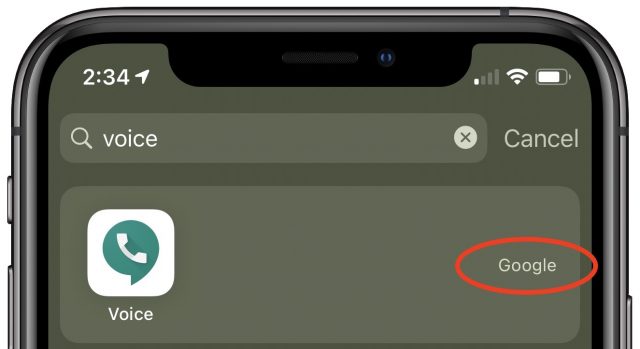
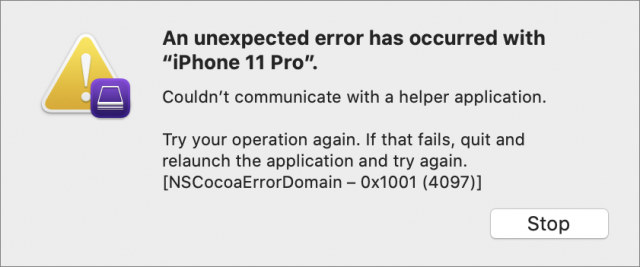
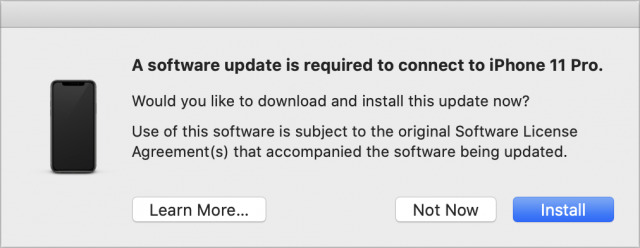
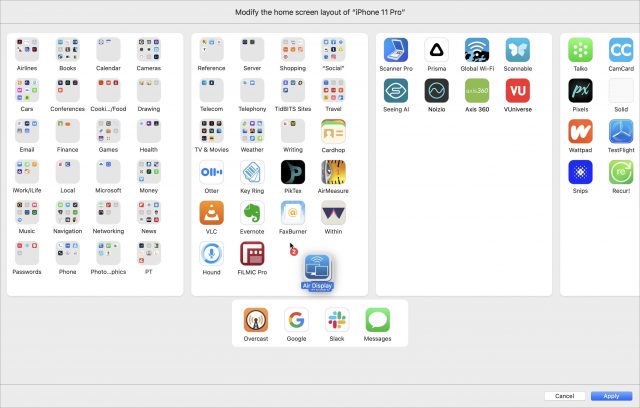
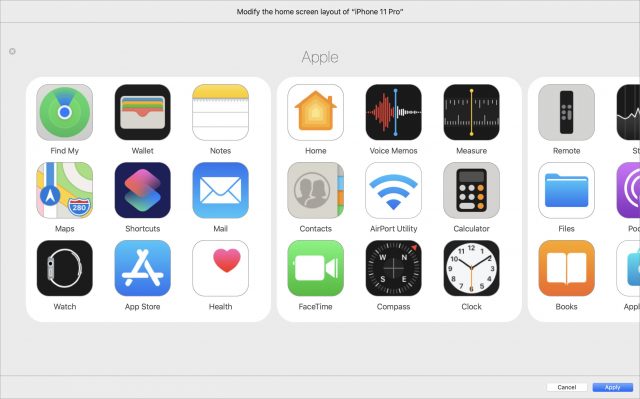
There, I’m afraid, is your problem; I keep one of my Macs on 10.13 for exactly this reason. (It’s also the last MacOS version that allows good ad-blocking in Safari, and the second-to-last that supports the last good version of M$ Word, or at least the last version I was willing to pay for.) I would have hoped that something like iMazing could manage the lost functionality, but so far haven’t found anything.
Moving apps on my iPad Air2 is a frustrating experience. Having entered “jiggle” mode (nobody at Apple remembers about “jiggle” TV shows) I drag an icon either within the same screen or to another a few screens over. On the way to the planned destination, the very slightest touch of any app or folder icon immediately opens it up and puts my app within it.
No pause, no delay. I have to let go of my touch and have the app go into it’s undesired new home, then drag it out, and hope I don’t go near another icon again (but I usually do). It takes a few tries just to get it where I wanted it to go. When I’m near the MacBook Pro, iMazing is my go-to for that and other app management.
For me the easiest way to move an app or two from one screen to another on an iPad is to use the dock as a temporary place to hold the icons. Drag the icon to the dock, swipe to the screen where you want the icon to be, and then drag the icon onto that screen. Because the iPad dock can hold a lot of icons, this is easier than on the iPhone, which is limited to four icons.
Good suggestion. I’ll try that. Adding an item to, or creating a folder, there is supposed to be a slight delay rather than being instantaneous. And it doesn’t even take a full “drop” onto the icon, just barely grazing a corner pops open the “folder.”
Good news! Latest version of configurator 2 (2.13.1) now works again.
macOS 10.15.6 Catalina
tested on
iPhone X iOS 14.0
and iPad Pro iPadOS 14.0
MUCH better. Best part is you can manipulate pages
to add a page, you have to move at least 2 apps to the last blank page. Then you can drag where you want. Only one app will merge when you move the page.
I couldn’t figure out how to pull apps out of a folder. I just did it on the device side.
Interaction is pretty easy.
Reviewing article I see how to remove app from folder. I will try.
Several of the tips in the article help you work around these problems.
Sadly, that was the version I was using that didn’t work in my testing.
Sorry. Sigh.
I agree older version was broken. It wouldn’t write new layout back to device.
All I can suggest is all 3 devices were at latest public release (not beta). 10.15.6 and iOS 14.0
I did have to do the inline configurator update, even after app store update. Seems shoddy to me.
What update is this? I didn’t see any additional updates after launching Apple Configurator 2.
Same update and works the same way when you plug an iDevice in, but you only have to do it once after each new piece of hardware is introduced. So if you already did it to update iOS/iPadOS then you won’t need to do it again for Configuator 2 or vice versa.
I tried Apple Configurator 2 on the latest Big Sur beta (running from an external SSD). It works fine with some caveats. It UNHIDES all of your Home Screens (if you have any hidden). If you’ve downloaded new apps and only saved them in the App Library then they are added to the first available spot on the next Home Screen. More testing is required but at least the Apply Button now saves the changes.
I also just discovered it removed the widgets from my Home Screen.
Regarding the section on “Moving a Stack of Apps All at Once,” I’m still on iOS 13, and when dropping a stack it unloads last-in/first-out order, not first-in/first-out order as described. (I believe this was also true for iOS 12.)
Has anyone ever developed an app that would put apps in alphabetical order? Once in alpha order you could just pull out your most frequently used apps, put them on the home screen, and then easily find the remainder in alpha order.
Swiping to the last screen on the right, and clicking the search box shows a alphabetical list of apps. Ios14.
Settings / General / Reset / Reset Home Screen layout I believe does this (at least for third party apps.) It removes non-default folders and then lays out the third party apps in alphabetical order in as many home screens as it takes. (I could be wrong; I’d test it myself, but don’t feel like messing up my home screen layouts.)
Thank you for the useful tip. Missed the ability to use a mac to easily arrange apps on iPhone since the departure of iTunes.
You say " whenever I tried to save my changes by clicking the Apply button, I got this error dialog…". I have installed the Configurator on my MBP and it works smoothly.
Does Apple cover these tips in their documentation anywhere? Excuse the rant, but all these functionalities exist because someone programmed them in, so they should be documented somewhere that the average user could find? I find as the OS and apps become more complex, they become less and less intuitive to use. So many functionalities these days are hidden behind non-obvious swipes, holds, tap, double-tap, triple-tap, single/multi-finger sequences of secret-handshakes gestures (I guess I’m speaking of touch screen interfaces in general) that they are un-discoverable. And to make matters worse, different apps implement the same gestures differently. I so miss the days of a simpler iOS, and unfortunately those days are long gone.
There is a Tips iOS app.
iMazing isn’t as good as the old iTunes, but it does allow some app management.
“…particularly if you end up hovering over another app just slightly too long and invoking the folder creation process.” This is one of the worst misfeatures I’ve ever seen in any OS, and is totally ADA noncompliant. Is there a way to turn it off or set the hover time to something reasonable? How does Apple manage to perpetuate the myth that their systems are easy to use?
So frustrating moving apps, why it was ever moved as an option in itunes i can’t understand. this was the logical place to keep it, as you sync your phone via itunes.
So true, I don’t understand how Apple makes some things so intuitive and easy and then makes other things so difficult and hard to figure out.
This article is useful, but the author says, “My article has tips for workarounds on this or that,” but that overlooks a serious problem.
You don’t do an overhaul of your iphone screen layout that often, so there is no way you are gonna remember all that stuff. It should either be easy, or it should have a way to do it from iTunes where you could use the power of a computer to do heavy lifting for you.
The best tip on here is to use the dock. Even on an iphone, since you can stack lots in a folder - but God have mercy on your soul as you try to remove things from that folder. It is a disaster honestly.
Having just got a new phone and contemplating the number of apps I have installed.
I have realised two things. First is that a lot of the apps that were there before I upgraded to IOS14 do not work any more. It tells me the developer needs to update them.
Secondly, looking through the apps, I realise that I installed them once thinking they would be handy, but have never used them again.
So maybe it might be worthwhile to spend an afternoon assessing the apps you have?
Sadly it cannot handle newer iPhones. It just says iTunes needs to be upgraded for an iPhone 12.
I guess since iOS14 I noticed an annoying behaviour while moving apps to another screen during ‘jiggle’. If that screen is full and you want to land the app in a certain folder, the first thing that happens is that the last app or folder on that screen is moved to the next screen (‘to make space’?).
It doesn’t come back after you stored the app in the folder.
Moreover, if the next screens are also full, you get a domino effect and thus moving one app leads to the misorganisation of some of your full screens.
Anyone the same experiece and/or solution?
There’s definitely something going on here, though I can’t quite figure out the variables. Sometimes the last app on a full screen comes back after leaving jiggle mode, but other times it doesn’t.
Latest version of Configurator 2 (2.14) works OK with iOS 14.7.1. which I’m glad about because who wants to mess around on the iPhone screen to do this, even with all fancy-schmancy tricks described?